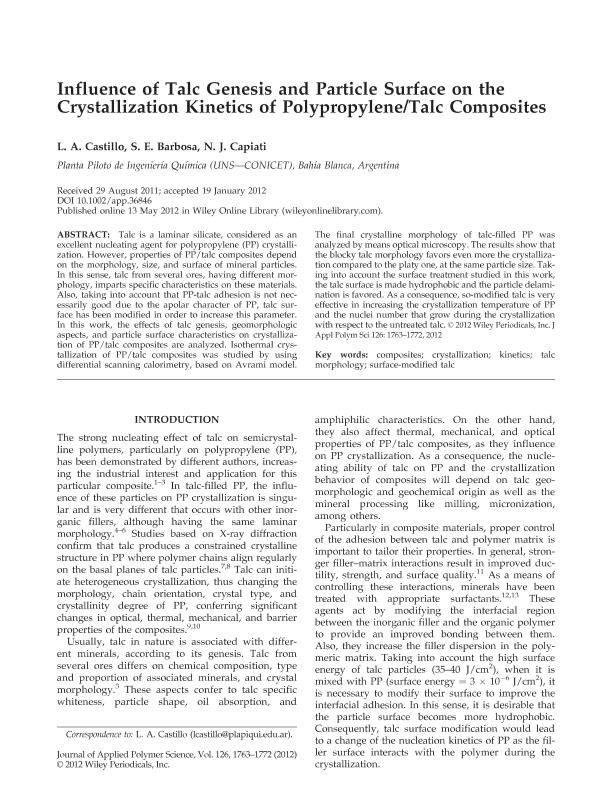Mostrar el registro sencillo del ítem
dc.contributor.author
Castillo, Luciana Andrea

dc.contributor.author
Barbosa, Silvia Elena

dc.contributor.author
Capiati, Numa Jose

dc.date.available
2019-05-27T21:32:13Z
dc.date.issued
2012-12-08
dc.identifier.citation
Castillo, Luciana Andrea; Barbosa, Silvia Elena; Capiati, Numa Jose; Influence of talc genesis and particle surface on the crystallization kinetics of polypropylene/talc composites; John Wiley & Sons Inc; Journal of Applied Polymer Science; 126; 5; 8-12-2012; 1763-1772
dc.identifier.issn
0021-8995
dc.identifier.uri
http://hdl.handle.net/11336/77274
dc.description.abstract
Talc is a laminar silicate, considered as an excellent nucleating agent for polypropylene (PP) crystallization. However, properties of PP/talc composites depend on the morphology, size, and surface of mineral particles. In this sense, talc from several ores, having different morphology, imparts specific characteristics on these materials. Also, taking into account that PP-talc adhesion is not necessarily good due to the apolar character of PP, talc surface has been modified in order to increase this parameter. In this work, the effects of talc genesis, geomorphologic aspects, and particle surface characteristics on crystallization of PP/talc composites are analyzed. Isothermal crystallization of PP/talc composites was studied by using differential scanning calorimetry, based on Avrami model. The final crystalline morphology of talc-filled PP was analyzed by means optical microscopy. The results show that the blocky talc morphology favors even more the crystallization compared to the platy one, at the same particle size. Taking into account the surface treatment studied in this work, the talc surface is made hydrophobic and the particle delamination is favored. As a consequence, so-modified talc is very effective in increasing the crystallization temperature of PP and the nuclei number that grow during the crystallization with respect to the untreated talc.
dc.format
application/pdf
dc.language.iso
eng
dc.publisher
John Wiley & Sons Inc

dc.rights
info:eu-repo/semantics/openAccess
dc.rights.uri
https://creativecommons.org/licenses/by-nc-sa/2.5/ar/
dc.subject
Composites
dc.subject
Crystallization
dc.subject
Kinetics
dc.subject
Surface-Modified Talc
dc.subject
Talc Morphology
dc.subject.classification
Recubrimientos y Películas

dc.subject.classification
Ingeniería de los Materiales

dc.subject.classification
INGENIERÍAS Y TECNOLOGÍAS

dc.title
Influence of talc genesis and particle surface on the crystallization kinetics of polypropylene/talc composites
dc.type
info:eu-repo/semantics/article
dc.type
info:ar-repo/semantics/artículo
dc.type
info:eu-repo/semantics/publishedVersion
dc.date.updated
2019-05-14T17:50:07Z
dc.identifier.eissn
1097-4628
dc.journal.volume
126
dc.journal.number
5
dc.journal.pagination
1763-1772
dc.journal.pais
Estados Unidos

dc.journal.ciudad
Nueva York
dc.description.fil
Fil: Castillo, Luciana Andrea. Consejo Nacional de Investigaciones Científicas y Técnicas. Centro Científico Tecnológico Conicet - Bahía Blanca. Planta Piloto de Ingeniería Química. Universidad Nacional del Sur. Planta Piloto de Ingeniería Química; Argentina
dc.description.fil
Fil: Barbosa, Silvia Elena. Consejo Nacional de Investigaciones Científicas y Técnicas. Centro Científico Tecnológico Conicet - Bahía Blanca. Planta Piloto de Ingeniería Química. Universidad Nacional del Sur. Planta Piloto de Ingeniería Química; Argentina
dc.description.fil
Fil: Capiati, Numa Jose. Consejo Nacional de Investigaciones Científicas y Técnicas. Centro Científico Tecnológico Conicet - Bahía Blanca. Planta Piloto de Ingeniería Química. Universidad Nacional del Sur. Planta Piloto de Ingeniería Química; Argentina
dc.journal.title
Journal of Applied Polymer Science

dc.relation.alternativeid
info:eu-repo/semantics/altIdentifier/url/https://onlinelibrary.wiley.com/doi/abs/10.1002/app.36846
dc.relation.alternativeid
info:eu-repo/semantics/altIdentifier/doi/http://dx.doi.org/10.1002/app.36846
Archivos asociados
